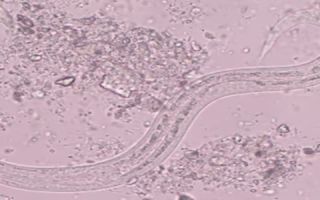The intestinal eel or intestinal strongyloides (Strongyloides stercoralis) is an intestinal nematode, the causative agent of strongyloidiasis.
The symptoms, diagnosis and treatment of this disease are described in the article “Strongyloidiasis” .
Appearance
Parasitic females are 2 mm long, parasitic males are 0.7 mm long, free-living females are 1 mm long, and males are 0.8 mm long.
The uniqueness of this species among human parasites is that for several generations these helminths can live in the soil, feeding on bacteria.
Life cycle
In the human body, helminths live in the small intestine . There, females lay eggs, from which rhabdite larvae hatch. They have a relatively short muscular esophagus with an expanded distal bulb.
The larvae leave the human body in feces and enter the soil, where they molt twice and develop into a filariform larva (infectious for humans) with a long esophagus of equal width along its entire length. The length of the larva is 0.55 mm, life expectancy is 12 days.
Living conditions
Intestinal eels belong to the group of parasitic nematodes that have not yet lost the ability to live in the external environment. In the development cycle of these helminths, free-living generations are observed.
Rhabditiform eel larvae that fall into the soil, under favorable conditions (soil temperature 26-28ºС, neutral or slightly alkaline pH, high humidity), molt three times and turn into free-living adult worms - females and males.
After copulation, females lay eggs in the soil, from which rhabditiform larvae emerge. They give rise to a new generation of free-living worms. When living conditions deteriorate (decrease in humidity and skin temperature), rhabditiform larvae transform into filariform larvae, which can infect humans. If the soil dries out, its temperature drops below 0ºС, and the larvae die.







